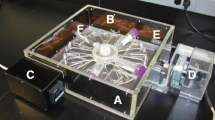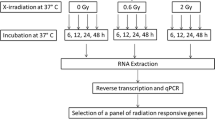Abstract
In the field of biodosimetry, the current accepted method for evaluating radiation dose fails to meet the need of rapid, large-scale screening, and most RNA marker–related studies of biodosimetry are concentrating on a single type of ray, while some other potential factors, such as trauma and burns, have not been covered. Microarray datasets that contain the data of human peripheral blood samples exposed to X-ray, neutron, and γ-ray radiation were obtained from the GEO database. Totally, 33 multi-type ray co-induced genes were obtained at first from the differentially expressed genes (DEGs) and key genes identified by weighted gene co-expression network analysis (WGCNA), and these genes were mainly enriched in DNA damage, cellular apoptosis, and p53 signaling pathway. Following transcriptome sequencing of blood samples from 11 healthy volunteers, 13 patients with severe burns, and 37 patients with severe trauma, 6635 trauma-related DEGs and 7703 burn-related DEGs were obtained. Through the exclusion method, a total of 12 radiation-specific genes independent of trauma and burns were identified. ROC curve analysis revealed that the DDB2 gene performed the best in diagnosis of all three types of ray radiation, while correlation analysis showed that the MDM2 gene was the best in assessment of radiation dose. The results of multiple-linear regression analysis indicated that such analysis could improve the accuracy in assessment of radiation dose. Moreover, the DDB2 and MDM2 genes remained effective in radiation diagnosis and assessment of radiation dose in an external dataset. In general, the study brings new insights into radiation biodosimetry.








Similar content being viewed by others
Data availability
Data available on request from the authors.
References
Ainsbury EA, Bakhanova E, Barquinero JF, Brai M, Chumak V, Correcher V, Darroudi F, Fattibene P, Gruel G, Guclu I, Horn S, Jaworska A, Kulka U, Lindholm C, Lloyd D, Longo A, Marrale M, Monteiro Gil O, Oestreicher U, Pajic J, Rakic B, Romm H, Trompier F, Veronese I, Voisin P, Vral A, Whitehouse CA, Wieser A, Woda C, Wojcik A, Rothkamm K (2011) Review of retrospective dosimetry techniques for external ionising radiation exposures. Radiat Prot Dosimetry 147:573–592
Amundson SA, Grace MB, McLeland CB, Epperly MW, Yeager A, Zhan Q, Greenberger JS, Fornace AJ Jr (2004) Human in vivo radiation-induced biomarkers: gene expression changes in radiotherapy patients. Cancer Res 64:6368–6371
Broustas CG, Xu Y, Harken AD, Chowdhury M, Garty G, Amundson SA (2017) Impact of neutron exposure on global gene expression in a human peripheral blood model. Radiat Res 187:433–440
Byrum SD, Burdine MS, Orr L, Mackintosh SG, Authier S, Pouliot M, Hauer-Jensen M, Tackett AJ (2017) Time- and radiation-dose dependent changes in the plasma proteome after total body irradiation of non-human primates: implications for biomarker selection. PLoS ONE 12:e0174771
Coleman CN, Koerner JF (2016) Biodosimetry: medicine, science, and systems to support the medical decision-maker following a large scale nuclear or radiation incident. Radiat Prot Dosimetry 172:38–46
Demidenko E, Williams BB, Swartz HM (2009) Radiation dose prediction using data on time to emesis in the case of nuclear terrorism. Radiat Res 171:310–319
Fan Z, Wang Y, Niu R (2022) Identification of the three subtypes and the prognostic characteristics of stomach adenocarcinoma: analysis of the hypoxia-related long non-coding RNAs. Funct Integr Genom 22:919–936
Flood AB, Nicolalde RJ, Demidenko E, Williams BB, Shapiro A, Wiley AL Jr, Swartz HM (2011) A framework for comparative evaluation of dosimetric methods to triage a large population following a radiological event. Radiat Meas 46:916–922
Goans RE, Holloway EC, Berger ME, Ricks RC (1997) Early dose assessment following severe radiation accidents. Health Phys 72:513–518
Hassan SH, Sferra G, Simiele M, Scippa GS, Morabito D, Trupiano D (2022) Root and shoot biology of Arabidopsis halleri dissected by WGCNA: an insight into the organ pivotal pathways and genes of an hyperaccumulator. Funct Integr Genom 22:1159–1172
Holley AK, Miao L, St Clair DK, St Clair WH (2014) Redox-modulated phenomena and radiation therapy: the central role of superoxide dismutases. Antioxid Redox Signal 20:1567–1589
Homer MJ, Raulli R, DiCarlo-Cohen AL, Esker J, Hrdina C, Maidment BW, Moyer B, Rios C, Macchiarini F, Prasanna PG, Wathen L (2016) United States Department of Health and Human Services Biodosimetry and Radiological/Nuclear Medical Countermeasure Programs. Radiat Prot Dosimetry 171:85–98
Kabacik S, Mackay A, Tamber N, Manning G, Finnon P, Paillier F, Ashworth A, Bouffler S, Badie C (2011) Gene expression following ionising radiation: identification of biomarkers for dose estimation and prediction of individual response. Int J Radiat Biol 87:115–129
Kannan K, Amariglio N, Rechavi G, Jakob-Hirsch J, Kela I, Kaminski N, Getz G, Domany E, Givol D (2001) DNA microarrays identification of primary and secondary target genes regulated by p53. Oncogene 20:2225–2234
Lacombe J, Sima C, Amundson SA, Zenhausern F (2018) Candidate gene biodosimetry markers of exposure to external ionizing radiation in human blood: a systematic review. PLoS ONE 13:e0198851
Liu L, Yang Y, Han X, Hou J (2022) The identification and validation of hub genes associated with advanced IPF by weighted gene co-expression network analysis. Funct Integr Genomics 22:1127–1138
Lu TP, Hsu YY, Lai LC, Tsai MH, Chuang EY (2014) Identification of gene expression biomarkers for predicting radiation exposure. Sci Rep 4:6293
Manning G, Kabacik S, Finnon P, Bouffler S, Badie C (2013) High and low dose responses of transcriptional biomarkers in ex vivo X-irradiated human blood. Int J Radiat Biol 89:512–522
Mao C, Gao Y, Wan M, Xu N (2022) Identification of glycolysis-associated long non-coding RNA regulatory subtypes and construction of prognostic signatures by transcriptomics for bladder cancer. Funct Integr Genom 22:597–609
Ministry of Health of the People’s Republic of China (2011) GBT28236–2011 Biological dose estimation by chromosome aberration [S]. Standards Press of China, Beijing
O’Brien G, Cruz-Garcia L, Majewski M, Grepl J, Abend M, Port M, Tichy A, Sirak I, Malkova A, Donovan E, Gothard L, Boyle S, Somaiah N, Ainsbury E, Ponge L, Slosarek K, Miszczyk L, Widlak P, Green E, Patel N, Kudari M, Gleeson F, Vinnikov V, Starenkiy V, Artiukh S, Vasyliev L, Zaman A, Badie C (2018) FDXR is a biomarker of radiation exposure in vivo. Sci Rep 8:684
Oh JH, Wong HP, Wang X, Deasy JO (2012) A bioinformatics filtering strategy for identifying radiation response biomarker candidates. PLoS ONE 7:e38870
Park JG, Paul S, Briones N, Zeng J, Gillis K, Wallstrom G, LaBaer J, Amundson SA (2017) Developing human radiation biodosimetry models: testing cross-species conversion approaches using an ex vivo model system. Radiat Res 187:708–721
Pawlik TM, Keyomarsi K (2004) Role of cell cycle in mediating sensitivity to radiotherapy. Int J Radiat Oncol Biol Phys 59:928–942
Rana S, Kumar R, Sultana S, Sharma RK (2010) Radiation-induced biomarkers for the detection and assessment of absorbed radiation doses. J Pharm Bioallied Sci 2:189–196
Rump A, Stricklin D, Lamkowski A, Eder S, Abend M, Port M (2016) Reconsidering current decorporation strategies after incorporation of radionuclides. Health Phys 111:204–211
Sproull MT, Camphausen KA, Koblentz GD (2017) Biodosimetry: a future tool for medical management of radiological emergencies. Health Secur 15:599–610
Sullivan JM, Prasanna PG, Grace MB, Wathen LK, Wallace RL, Koerner JF, Coleman CN (2013) Assessment of biodosimetry methods for a mass-casualty radiological incident: medical response and management considerations. Health Phys 105:540–554
Wang L, Wang Y, Bi J (2022) In silico development and experimental validation of a novel 7-gene signature based on PI3K pathway-related genes in bladder cancer. Funct Integr Genomics 22:797–811
Wong KF, Siu LL, Ainsbury E, Moquet J (2013) Cytogenetic biodosimetry: what it is and how we do it. Hong Kong Med J 19:168–173
Acknowledgements
We are grateful for the support of all the healthy volunteers and clinical patients included in the study, and we thank Sangon Biotech (Shanghai, China) for the assistance in transcriptome sequencing.
Author information
Authors and Affiliations
Contributions
Ling-Hu Cai, Xiang-Yu Chen, and Wei Qian were mainly responsible for research implementation and bioinformatics analysis and wrote the manuscript. Chuan-Chuan Liu and Li-Jia Yuan contributed to the collection of peripheral blood samples of patients with severe trauma and healthy volunteers. Yue Li contributed to the collection of peripheral blood samples of patients with severe burns. Liang Zhang, Chao Nie, and Zhen Liu provided assistance for statistical analysis. Tian Li is responsible for article revision and supervision. Ming-Hua Liu was responsible for research management and coordination and critically reviewed the manuscript.
Corresponding author
Ethics declarations
Competing interests
The authors declare no competing interests.
Ethics approval and consent to participate
This study was approved by the Ethics Committee of the First Affiliated Hospital of Army Medical University, PLA (Ethics approval number: (A) KY2021082, approval date: November 8, 2021). Written informed consent for the use of medical and transcriptome data for publication was obtained from all participants.
Conflict of interest
The authors declare no competing interests.
Additional information
Publisher's Note
Springer Nature remains neutral with regard to jurisdictional claims in published maps and institutional affiliations.
Supplementary Information
Below is the link to the electronic supplementary material.
Rights and permissions
Springer Nature or its licensor (e.g. a society or other partner) holds exclusive rights to this article under a publishing agreement with the author(s) or other rightsholder(s); author self-archiving of the accepted manuscript version of this article is solely governed by the terms of such publishing agreement and applicable law.
About this article
Cite this article
Cai, LH., Chen, XY., Qian, W. et al. DDB2 and MDM2 genes are promising markers for radiation diagnosis and estimation of radiation dose independent of trauma and burns. Funct Integr Genomics 23, 294 (2023). https://doi.org/10.1007/s10142-023-01222-w
Received:
Revised:
Accepted:
Published:
DOI: https://doi.org/10.1007/s10142-023-01222-w




